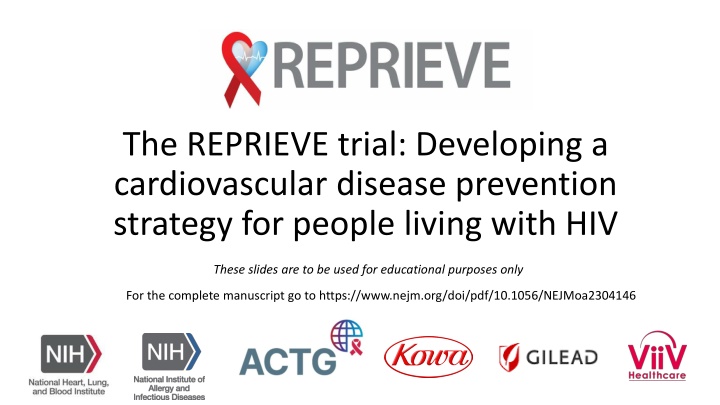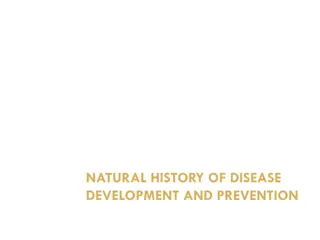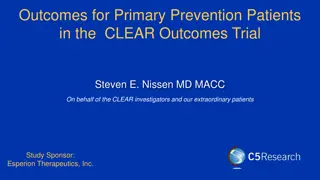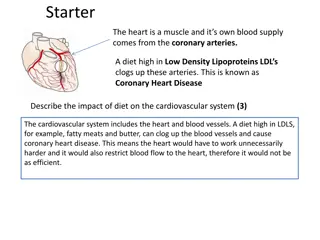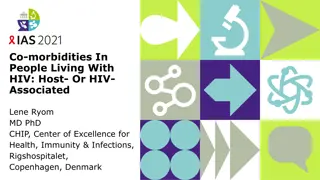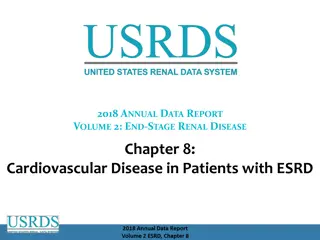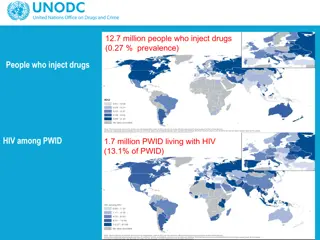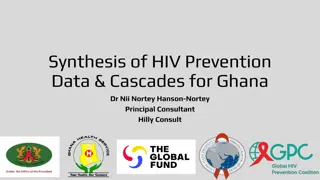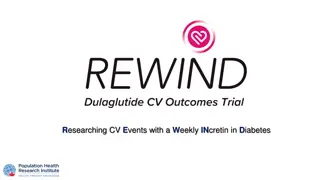The REPRIEVE Trial: Developing Cardiovascular Disease Prevention Strategy for People Living with HIV
The REPRIEVE trial focuses on developing a cardiovascular disease prevention strategy for individuals living with HIV. It addresses the increased risk of CVD in this population, even with good viral suppression. The study evaluates the use of pitavastatin, a statin with anti-inflammatory properties, to prevent major adverse cardiovascular events. The trial's inclusion criteria target HIV patients aged 40-75 years with specific LDL levels and no known ASCVD. The study aims to bridge the comorbidity gap and improve the cardiovascular health of people living with HIV.
Download Presentation

Please find below an Image/Link to download the presentation.
The content on the website is provided AS IS for your information and personal use only. It may not be sold, licensed, or shared on other websites without obtaining consent from the author.If you encounter any issues during the download, it is possible that the publisher has removed the file from their server.
You are allowed to download the files provided on this website for personal or commercial use, subject to the condition that they are used lawfully. All files are the property of their respective owners.
The content on the website is provided AS IS for your information and personal use only. It may not be sold, licensed, or shared on other websites without obtaining consent from the author.
E N D
Presentation Transcript
The REPRIEVE trial: Developing a cardiovascular disease prevention strategy for people living with HIV These slides are to be used for educational purposes only For the complete manuscript go to https://www.nejm.org/doi/pdf/10.1056/NEJMoa2304146
Key REPRIEVE Results and the Utility of Statins Among PWH: What Have We Learned?
Cardiovascular Disease is Increasing in PWH, Contributing to a Persistent Comorbidity Gap POPULATION WITH HIV PWOH, total yrs PWH, total yrs PWOH, comorbidity free yrs PWH, comorbidity free yrs Marcus et al., JAMA Network Open 2020; Feinstein et al., Am J Card 2016
Rationale PWH demonstrate increased cardiovascular disease (CVD) (50-100%) and excess plaque controlling for traditional risk, even at a young age ART reduces comorbidities (SMART) but residual immune activation persists, even with good viral suppression - ART alone is not sufficient to prevent CVD Statins lower LDL cholesterol, a main driver of CVD in PWH, but also residual immune activation and inflammation, including among PWH Pitavastatin is a moderate intensity statin, unaffected by ART, with good LDL and anti-inflammatory properties We hypothesized pitavastatin would prevent MACE through these effects in PWH, at low to moderate risk, for whom statins not typically prescribed under current guidelines MACE = major adverse cardiovascular events
Beyond LDL: Pleiotropic Effects of Statins Statins primary effect is to inhibit HMG-CoA reductase to lower LDL cholesterol Statins have many other beneficial effects to reduce vascular disease Reduced Oxidative Stress Anti-inflammatory Improved Endothelial Function/Vascular Tone STATINS Anti-thrombotic Plaque Stabilization Immunomodulation Arch Toxicol 2023 97:1529
REPRIEVE Study Population Inclusion Criteria Documented HIV Receiving stable ART CD4+ > 100 cells/mm3 Age 40 years, 75 years No known atherosclerotic cardiovascular disease (ASCVD) 10-yr ASCVD risk score <7.5% LDL < 190 mg/dL 7.5% and 10% LDL, < 160 mg/dL >10% and 15%, LDL < 130 mg/dL Certain laboratory parameters Exclusion Criteria Current use of statins, gemfibrozil, or PCSK9 inhibitors Known decompensated cirrhosis Note: For LDL, to convert from mg/dL to SI (in mmol/L) multiply by 0.02586
REPRIEVE Trial Schema Screening and Consent Asymptomatic PWH on ART, with low-moderate ASCVD risk Time R N=7769 Randomization Intervention Pitavastatin Placebo Mechanistic SubStudy N=805, 2 yrs Mechanistic Primary Endpoint Coronary plaque, vascular Inflammation, immune activation Clinical Primary Endpoint CVD Death Unstable Angina Arterial Revasc PAD MI TIA & Stroke Individual components of primary endpoint and all cause mortality Secondary Endpoints Predictors of statin effects Inflammatory, immunological, metabolic biomarkers Statin safety and non AIDS comorbidities, DM, infections, cancer
Baseline Characteristics Total (N=7769) Pitavastatin (N=3888) Placebo (N=3881) Age (years) Median (Q1 Q3) 50 (45-55) 50 (45-55) 50 (45-55) Natal sex Male 5350 (69%) 2677 (69%) 2673 (69%) Female 2419 (31%) 1211 (31%) 1208 (31%) Gender identity Cisgender 7367 (95%) 3687 (95%) 3680 (95%) Transgender spectrum 127 (2%) 63 (2%) 64 (2%) Not reported 275 (4%) 138 (4%) 137 (4%) Race White 2704 (35%) 1634 (35%) 1340 (35%) Black/African American 3208 (41%) 1569 (40%) 1639 (42%) Asian 1138 (15%) 571 (15%) 567 (15%) CD4 count (cells/mm3) Median (Q1 Q3) 621 (448-827) 620 (449-832) 622 (445-824) Nadir CD4 count (cells/mm3) < 50 50-199 200 1409 (18%) 2392 (31%) 3706 (48%) 688 (18%) 1202 (31%) 1859 (49%) 721 (19%) 1190 (31%) 1847 (47%) HIV RNA (Copies/mL) < LLQ 5250 (88%) 617 (10%) 130 (2%) 1772 2641 (88%) 305 (10%) 63 (2%) 879 2609 (87%) 312 (10%) 67 (2%) 893 LLQ - < 400 400+ Missing ASCVD risk score, (%) Median (Q1 Q3) 4.5 (2.1-7.0) 4.5 (2.1-7.0) 4.5 (2.2-7.0) LDL-C (mg/dL) Median (Q1 Q3) 108 (87-128) 109 (87-128) 108 (87-127)
Recent Events and Trial Closure REPRIEVE is an events driven trial with 85% power to detect a HR of 0.70 with 288 planned events The DSMB convened at 75% of information for a pre- specified data review and closed the trial for efficacy, concluding there were no unanticipated safety concerns and that the benefits outweighed the risk of statin therapy in this group DSMB = data and safety monitoring board
Primary and Key Secondary Endpoints -35% vs Placebo -21% vs Placebo Grinspoon et al. NEJM 2023
Additional Findings Greater than 80% in both groups remained in follow up Adherence was verygood to excellent in the great majority of participants Adverse event-related discontinuation was low in each group (2% vs 1% pitavastatin vs placebo) Clinical initiation of a non-study statin occurred in 5.7% pitavastatin and 9.6% of placebo-treated participants, below threshold of concern All events adjudicated vis a vis relationship to COVID; only one MACE event was definitely related to COVID.
Primary Endpoints and MACE Components Grinspoon et al. NEJM 2023
Robust Effect Controlling for ASCVD Score and Other Factors Adjusted for: age, race, smoking, hypertension, LDL-C, nadir CD4, total ART duration and GBD region as covariates. Grinspoon et al. NEJM 2023
Effects on Key Subgroups Very consistent affect across major subgroups No treatment modification based on LDL, age, sex Generally consistent effects across race and GBD regions No treatment modification based on CD4, nadir CD4, HIV RNA, ART Duration GBD = global burden of disease Grinspoon et al. NEJM 2023
REPRIEVE Population Baseline Characteristics by Sex Total Men (N=5350) Women (N= 2419) Age (years) Median (Q1-Q3) 50 (45, 55) 50 (46, 55) 49 (44, 55) Race Black/African-American, N (%) 41% 34% 58% White, N (%) 35% 44% 15% Asian, N (%) 15% 13% 19% Current Cigarette Smoking (%) 25% 28% 18% Hypertension (%) 36% 34% 39% LDL-C (mg/dL) Median (Q1-Q3) 108 (87, 128) 107 (86, 126) 111 (90. 131) 10-y ASCVD Risk Score (%) Median (Q1-Q3) 4.5 (2.1, 7.0) 5.4 (3.3, 7.8) 1.9 (0.8, 4.3) BMI (kg/m2) Median (Q1-Q3) 25.8 (22.8, 29.4) 25.3 (22.6, 28.3) 27.2 (23.4, 32.1) Viral Load < LLQ (%) 88% 87% 88% CD4 count (cells/mm3) Median (Q1-Q3) 621 (448, 827) 598 (426, 795) 679 (496, 898)
MACE Rates in 10-year ASCVD Risk Score Subgroups by Sex Women Men men women z
Effect Size of Statin Rx to Reduce MACE = Consistent among Women vs. Men
Effects on LDL and NON-HDL Cholesterol 30% reduction in LDL in pitavastatin group, no change in placebo Durable effect over time Pitavastatin Placebo Grinspoon et al. NEJM 2023
Effect Larger than Anticipated Based on Lowering of LDL REPRIEVE LDL lowering matters but statin effect is beyond what is expected for LDL lowering alone Predicted 17% Note: 35% is point estimate, CI % is 17 52% Lancet 2010; 376: 1670-81
Safety DSMB concluded no unanticipated safety concerns Serious adverse events similar in each group: IRR 1.02 (0.92-1.14) Muscle-related symptoms were higher in the pitavastatin group but were mostly mild and only 1% withdrew for muscle-related symptomatology Diabetes rates increased in the pitavastatin group, but this increase was consistent with that seen in prior statin studies, was not significantly above rates demonstrated for the general population, and very few withdrew due to diabetes No effect on Grade 3 ALT or rhabdomyolysis was seen IRR: incidence rate ratio
Diabetes Rates in REPRIEVE vs. General Population Aged 45-64 per US Centers for Disease Control 12 MACE events in participants with diabetes: -4 in pitavastatin group -8 in placebo group Placebo Placebo IRR 1.34 (1.08-1.65) Pitavastatin Pitavastatin General 0.5 0.6 0.7 0.8 0.9 1 1.1 1.2 1.3 1.4 1.5 IRR: incidence rate ratio Centers for Disease Control and Prevention. Incidence of Newly Diagnosed Diabetes. https://www.cdc.gov/diabetes/data/statistics-report/newly-diagnosed-diabetes.html#print
Effects on Glucose Pitavastatin Placebo Grinspoon et al. NEJM 2023
Effects on Muscle Aches and Myalgias Muscle aches Muscle weakness Grinspoon et al. NEJM 2023
How Might the Findings of REPRIEVE Impact the Recommendations for Statin Therapy (2019 ACC/AHA Guidelines)? HIV was recently considered a risk enhancer, but its use in primary prevention had not been studied Previously unknown if PWH with low to moderate risk should be put on a statin and whether statin therapy would be successful in this context? REPRIEVE has taught us that yes this is the case, statin therapy will prevent MACE in low to moderate risk PWH
Statin Interactions with ART in PWH Slide Courtesy of Dr. Janet Lo
5-Yr Number Needed To Treat (NNT) to Prevent One MACE Event Increasing CVD with increasing ASCVD risk score Decreasing NNT with increasing ASCVD risk score NNT = number needed to treat Grinspoon et al. NEJM 2023
Will Pitavastatin be Available After REPRIEVE? The data from REPRIEVE are specific to pitavastatin, chosen because: little interaction with ART potent lipid lowering and anti-inflammatory effects Pitavastatin is available in many countries, but if it is not available, other statins that do not interact with ART may be effective Generic pitavastatin calcium will be more broadly available after Nov. 2023
Implications for Care of PWH Statin therapy, with lifestyle counselling, should be considered for PWH, even those with low to moderate predicted traditional risk, to reduce major cardiovascular events and death For PWH, the decision to take a statin should be individualized Shared decision making between individual and clinician All relevant factors including statin risks and benefits should be considered, including but not limited to the results of REPRIEVE. This may include drug interactions, metabolic factors, and patient preferences All conversations about risk should emphasize a heart healthy lifestyle, ideal diet, counselling on smoking, blood pressure, dyslipidemia, other CVD risks
Conclusions Despite HIV being considered a risk equivalent, no prior trial has assessed a primary prevention strategy for this group, who would not typically be recommended for statin therapy Among PWH 40-75, on ART, with low to moderate risk and normal range LDL, treatment with pitavastatin is effective and prevents MACE Considerations should be given to expanding treatment guidelines in this regard
